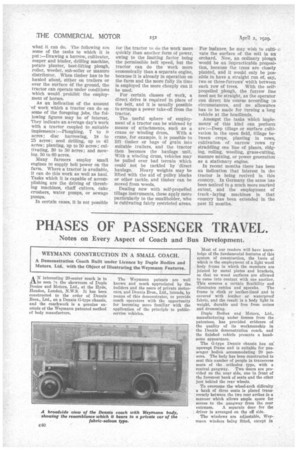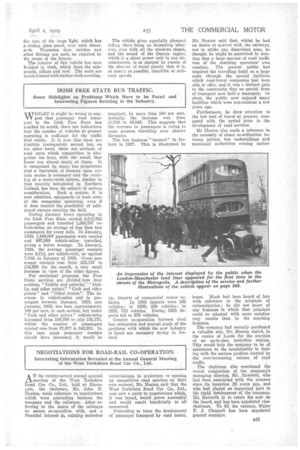PHASES OF PASSENGER TRAVEL.
Page 62

Page 63

If you've noticed an error in this article please click here to report it so we can fix it.
Notes on Every Aspect of Coach and Bus Development.
WEYMANN CONSTRUCTION IN A SMALL COACH.
A Demonstration Coach Built under Licence by Duple Bodies and Motors. Ltd. with the Object of Illustrating the Weymann Features.
AN interesting 20-seater coach is to be seen in the showroom of Duple Bouies and Motors, Ltd., at the Hyde, Hendon, London, N.W.9. It has been constructed to the order of Dennis Bros., Ltd., on a Dennis G-type chassis, and the coachwork is a genuine example of the Weymann patented method of body manufacture.
The Weymann patents are well known and mach appreciated by the builders and the users of private motorcars, and Dennis Bras., Ltd., intends, by means of this demonstrator, to provide coach operators with the opportunity for becoming more familiar with the application of the principle to publicservice vehicles. Most of our readers will have knowledge of the fundamental features of this system of construction, the tasis of which is the employment of a light wood body frame in which the members are jointed by metal plates and brackets, so that no wood surfaces are allowed to come into contact with one another. This ensures a ceitaiu flexibility and eliminates rattles and squeaks. The frame is cloth or leather-lined and is covered with leather or waterproof fabric, and the result is a body light in weight, durable and free from noises and drumming.
Duple Bodies and Motors, Ltd., manufacturing under licence from the patentees, has provided evidence of the quality of its workmanship in the Dennis demonstration coach, and the finished vehicle presents a handsome appearance.
The G-type Dennis chassis has an upswept frame and is suitable for passenger bodies accommodating 20 persons. The body has been constructed to seat this number of people in transverse seats of the orthodox type, with a central gangway. Two doors are provided on the near side, one in front of the foremost bank of seats and the other just behind the rear wheels.
To overcome the wheel-arch difficulty a bank of three seats is placed transyersely between the two rear arches in a manner which allows ample space for access to the gangway from the rear entrance. A separate door for the , driver is arranged on the off side. The windows are adjustable, Weymann winders being fitted, except in
the ease of the large light, which has a sliding glass panel, over each wheelarch. Weymann door catches and other fittings are used, as required by the terms of the licence.
The interior of this vehicle has been finished in cloth, which lines the sidepanels, pillars and roof. The seats are metal-framed with leather-cloth covering. The vehicle gives espedially pleasant riding, there being no drumming whatever, even with all the windows closed, and the sound of the Dennis engine, which is a silent power unit in any circumstances, is so damped by reason of the absence of metal panels, that it is, as nearly as possible, inaudible at ordinary speeds.












































































































